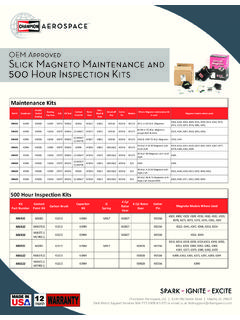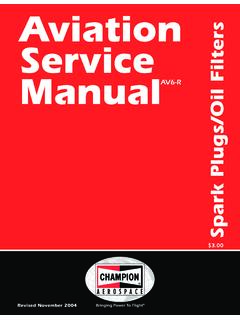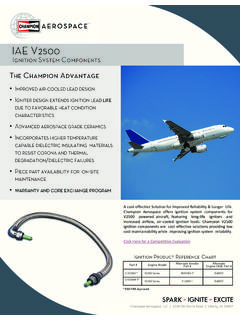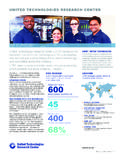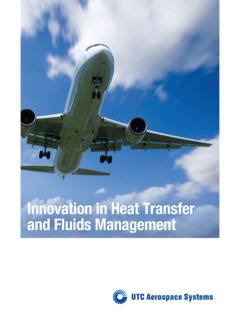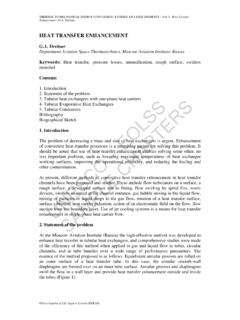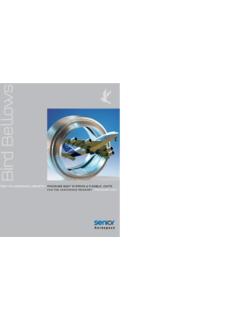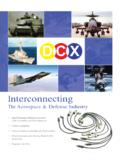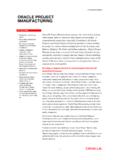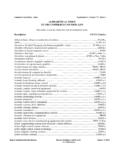Transcription of TECHNICAL SPOTLIGHT - Champion Aerospace
1 ECCN: 9E991 1230 Old Norris Rd Liberty, SC 26957 TECHNICAL SPOTLIGHT Subje ct: Champion Ignition Exciter Radiation Compliance to Globally Recognized Nuclear Standards Background Information Misinformation exists concerning Champion Ignition Exciter products that contain spark gap switches and compliance to Registration, Evaluation, Authorization and Restriction of Chemicals (REACH), United States Nuclear Regulatory Commission (NRC), and European Atomic Agency (EURATOM) standards. Champion believes that any action to prevent use of its radiation bearing ionization gas is in fact an Airframe or Engine Original Equipment Manufacturer environmental initiatives and is not a mandatory action enforced by the globally recognized Nuclear Authorities named above.
2 These Global Nuclear Authorities recognize the need for radiation bearing material in industry and have established exemptions to allow its use. End users of Champion Spark Gap Ignition Exciters can continue to use our products without TECHNICAL , environmental or regulatory concerns. Champion manufactures ignition exciters, some of which contain an extremely small amount of radioactive Tritiated Hydrogen (H3), better known as Tritium gas in the Spark Gap (high voltage switching component similar to an electron tube). Highly pedigreed radiation bearing spark gaps are used if the environmental temperature exceeds 121 C maximum, or if the customer is averse to using solid state switching devices.
3 Spark gap exciter designs have been used in turbine engine ignition systems on aircraft since the 1940s. They are a simple and reliable high voltage switch. They do require a small dose of radioactive gas in their construction for proper operation of the exciter throughout the required on engine life. The fundamental issue is that a radioactive isotope is required to maintain a consistent spark gap ionization voltage over the unit s operating life. Without the small amount of tritium gas in the spark gap, the ionization voltage of the gap can vary significantly over time and result in a potential decrease in the delivered energy of the exciter. There is no less hazardous alternative material that Champion can propose for use in our spark gaps that is more benign that Tritium.
4 Tritium is most widely used in the consumer industry in self-powered/illuminating lighting in applications such as signs, watches, compasses, and firearm gun sights. Tritium regulation is primarily due to its use in thermonuclear devices and not due to health considerations. It s important to note Champion does support environmental initiatives and has solid state designs that eliminate radiation bearing components. Champion introduced this solution in the mid-1990s and continues to advance it solid state offerings for today s engine requirements. NRC Re gulation Champion is licensed by the US NRC to purchase, to manufacture, process, produce or transfer products containing Tritium. It is important to note that the level of radioactive material in Champion s spark gap designs is extremely low.
5 In fact, the level is so low that the exciter does not need to be labeled as either radioactive or hazardous. The ignition exciter is classified as exempt according to the Code of Federal Regulation, CFR, Title 10, Chapter 1, Part 30, Section , which allows up to 10,000 microcuries (10 millicuries) of Tritium, to be contained in an electron tube. An exempt device is one which does not require special licensing or handling procedures. Subje ct: Champion Ignition Exciter Radiation Compliance to Globally Recognized Nuclear Standards 2 ECCN: 9E991 The average Champion supplied spark gap contains less than 25 microcuries of radiation from Tritium. The level of radiation from this tube does not exceed 1 millirad per hour at 1 centimeter from any surface when measured through 7 milligrams per square centimeter of absorber material.
6 This amount of Tritium and the level of radiation are the limits set by the NRC as being safe to handle. It should be noted that competitive product uses Kr-85 which is more hazardous than the Tritium used by Champion . It is only allowed to have 30 microcuries vs the 10,000 microcuries allowed for Tritium. REACH Re gulation The following addresses European Chemical Agency (ECHA) requiring Champion to provide safety data sheet to its customers in the event the customer product contains a substance that is: 1) Identified as a SCHV (Substance of Very High Concern) and 2) The mixture is greater than w/w. Currently Tritium gas inside the hermetically sealed spark gap is not listed on the ECHA Candidate List of Substances for Eventual Inclusion in Annex XIV (dated 11 January 2016) identifying the substance as a SVHC (Substance of Very High Concern).
7 Also to be noted is the weight/weight mix ratio of the Tritium gas to the ignition exciter. Calculations have been made to demonstrate that the Tritium gas weight to spark gap weight ratio is significantly below As a result of the calculation, if the Tritium was on the ECHA Candidate List, the extremely low weight/ weight ratio would still not require safety data sheets be provided to customers. Note: The actual calculations cannot be provided in this document due to the confidential nature of our spark gap design configuration. EURATOM Dire ctiv e EURATOM Council Directive 2013/59 Annex VII- Exemption and Clearance Criteria, Table B, Column 3 establishes Tritium unit activity level below 1 x 106 Becquerels is exempt from authorization/regulation by law.
8 The Champion spark gap activity from Tritium has been calculated to be below this 1 x 106 Becquerels threshold. Article 26 also establishes exemption criteria for which the Champion Spark Gap design meets. The exemption requirement defines the apparatus does not cause, in normal operating conditions, a dos rate exceeding 1 Sv/h at a distance of from any accessible surface . Note: The actual calculations cannot be provided in this document due to the confidential nature of our spark gap design configuration. Tritium Procure me nt Champion currently purchases the Tritium gas from a commercial supplier of the material. That manufacturer is AECL - Chalk River Laboratories in Chalk River, Ontario Canada.
9 Champion manufactures the spark gaps in compliance with all of the laws and regulations of both the Federal and state governments. Specifically: Code of Federal Regulation, Title 10, Chapter 1, Part 30, Section , Operating under US Nuclear Regulatory Commission License Number 39-23825-01E in conjunction with South Carolina Department of Health and Environmental Control License Number 505. Copies of the aforementioned documents will be made available for inspection at Champion s facility within 5 days of written notification by the customer. Subje ct: Champion Ignition Exciter Radiation Compliance to Globally Recognized Nuclear Standards 3 ECCN: 9E991 Handling, M aintaining and Disposal of Excite rs with Spark Gaps The glass spark gap tubes hermetically sealed, protected by rubber boots and are contained within a hermetically sealed, metallic enclosed ignition exciter.
10 This separation within the exciter and the component absorption of radiation within the unit reduces the amount of radiation at the cover to a point where there is no limit to the number of units that can safely be stored or shipped together without hazard. Should a spark gap fracture or it seal be compromised, the Tritium gas is biologically inert and will diffuse rapidly into the air. Because of the small quantity of gas present, it would take an inordinate number of tubes breaking simultaneously in a contained area to produce any significant airborne concentration of radiation that would be above natural background radiation. Tritium is a hazard only when taken inside the body (internal hazard).

